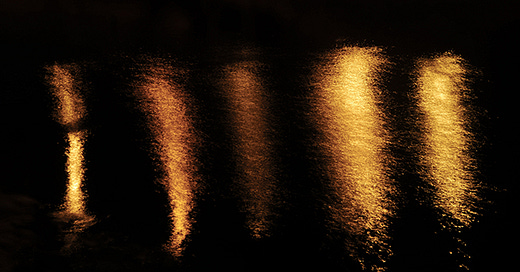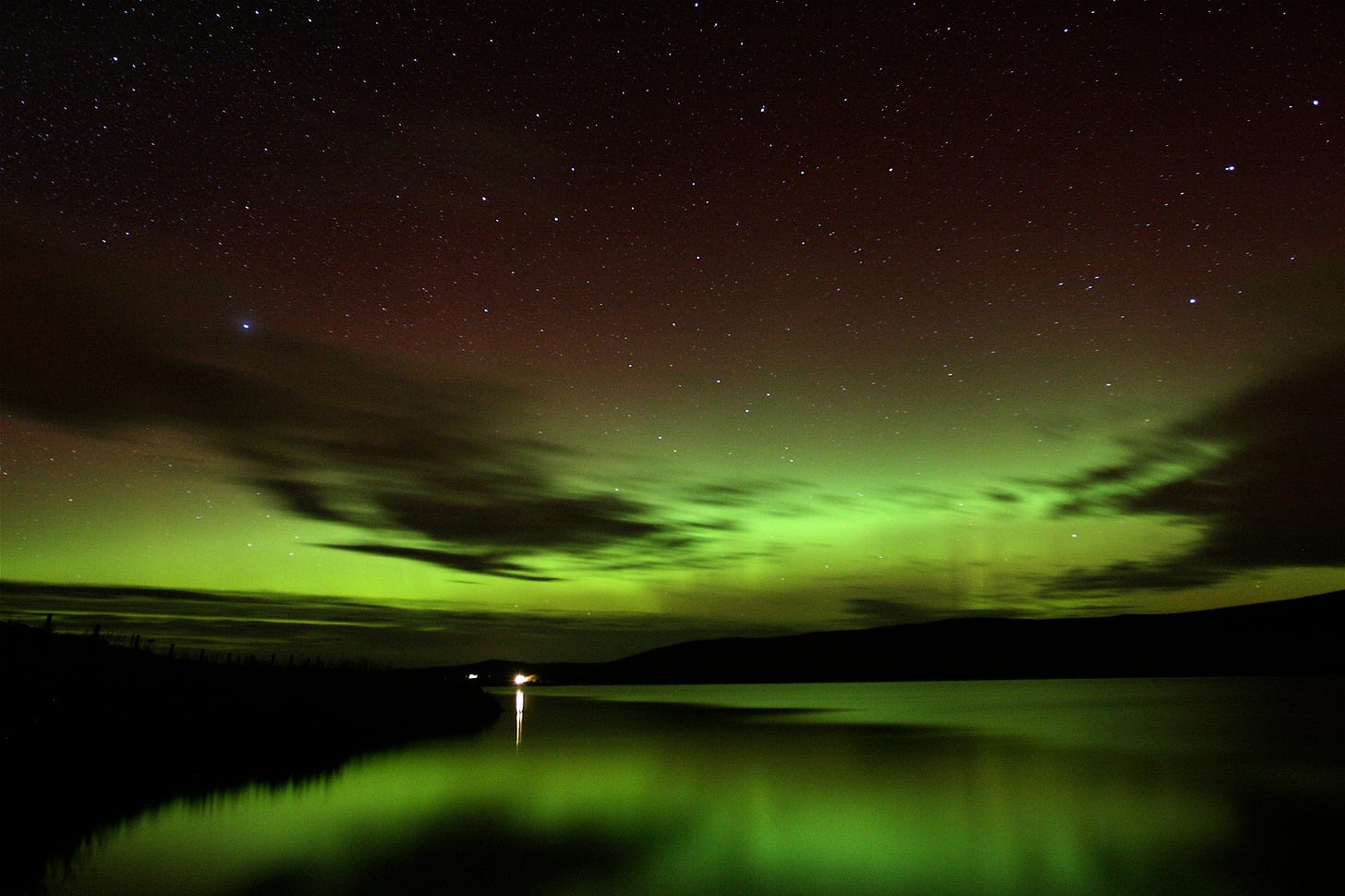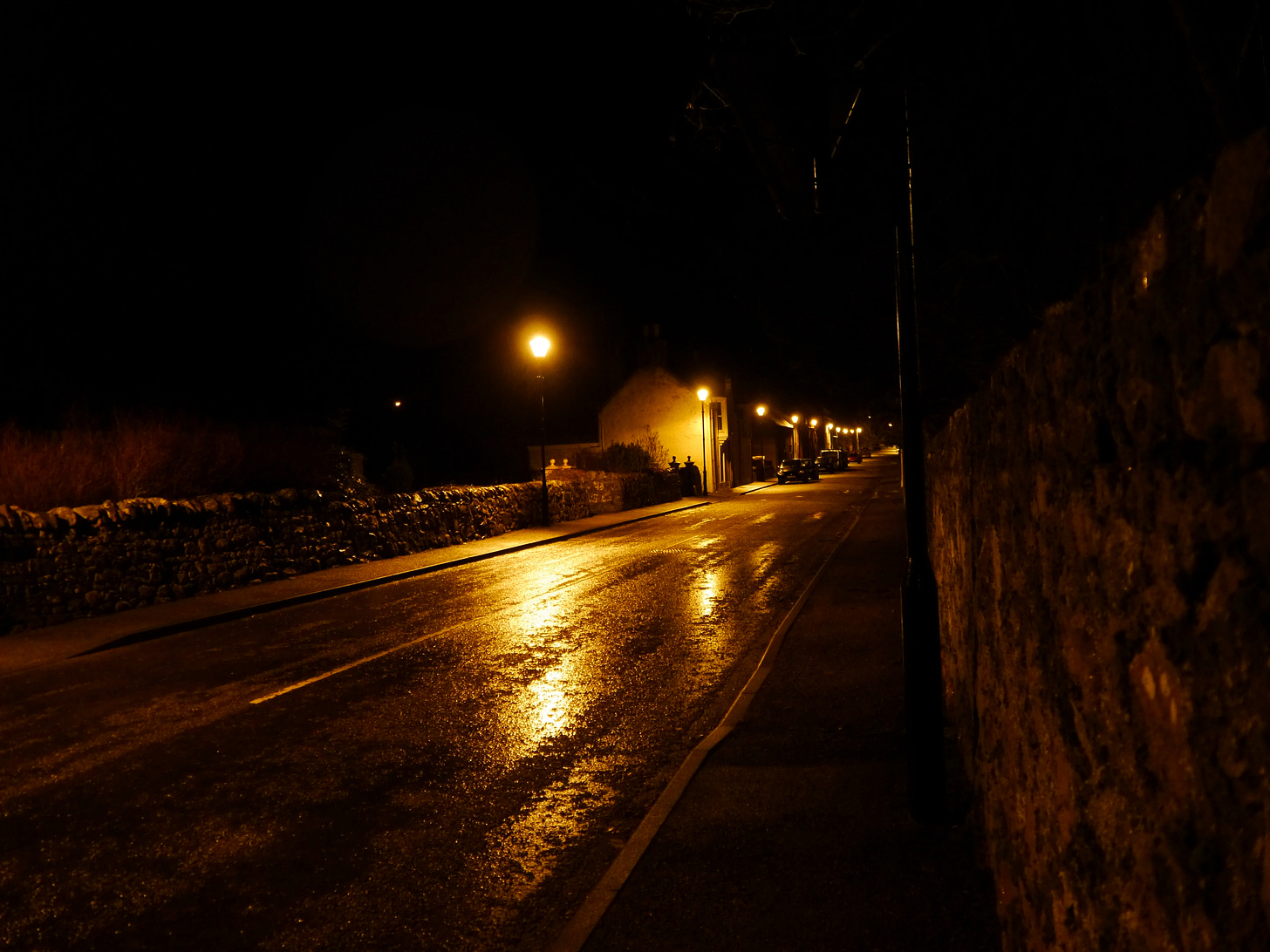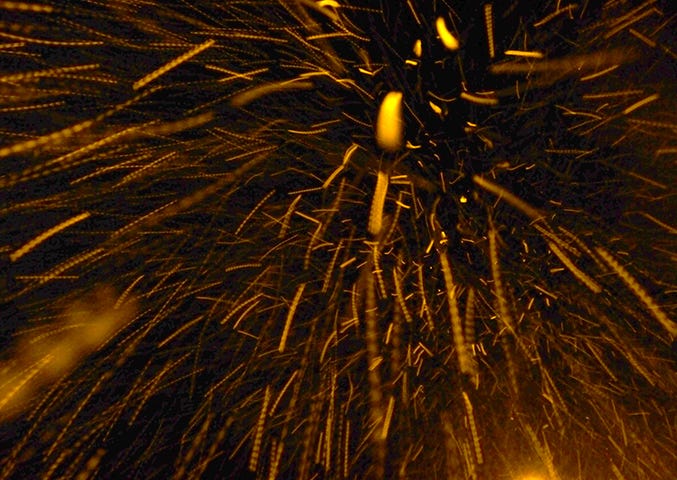A special welcome to new subscribers who’ve joined since The Life Boat was a Substack Featured Publication at the weekend. I hope you’ll like it here!
The clocks have changed and Winter is closing in fast on us here in Orkney. The influence of the sea means that our winters are milder than you might expect. But there’s no escaping the change of season. At 59 degrees North, the sun is now setting at 4pm and there’s still a way to go before the Solstice starts to tip us back towards the light.
It’s time to make friends with the dark again.
As Orkney’s best known writer George Mackay Brown wrote:
“Thermometer and barometer measure our seasons capriciously; the Orkney year should be seen rather as a stark drama of light and darknesss. In June and July, at midnight, the north is always red; the sun is just under the horizon; dawn mingles its fires with sunset. In midwinter the sun intrudes for only a few hours into the great darkness, but the January nights are magnificent — star-hung skies, the slow heavy swirling silk of the aurora borealis, the moon in a hundred waters; a silver plate, a broken honeycomb, a cluster of fireflies.”
This weekend, on Bonfire Night, the night was calm and clear, and we stood at our back door gazing north to watch a spectacular aurora play in the sky high above our neighbours’ firework display. The bright pops and crackles of the roman candles and rockets looked tiny, insignificant beneath the wide glowing arc that filled the northern skies and reached high above our heads.
The photographs and time-lapses we see of the aurora are deceptively garish. In reality the aurora is a soft sweep of palest green, sometimes with a faint hint of pink above. It moves in slow shimmers, like gauzy curtains rippling in a cosmic breeze. On good nights, an occasional burst of ghostly green searchlight reaches deep into the blackness between stars.
We haven’t seen many auroras over the last few winters. The sun has been going through a periodic minimum of sunspot activity. But in the last year it’s been resurgent, solar activity has increased, and auroras have been more frequent, brighter too. For the past two nights a soft shimmering has filled the whole northern sky. Orkney’s ‘mirrie dancers’ are, once more, frequent and welcome visitors.
Back in 2015, before the last solar minimum, I filmed an aurora using time-lapse to speed its gently sweeping movement. Instead of rising from the northern horizon this aurora spanned the whole vault above me, reaching upwards into space, too vast to focus on. I had to lie back on the grass to see it properly, flat on my back under its cold, silent grandeur, and let the whole wide sky fall into my eyes. Here’s the film I made. Watching it again now, it reminds me of ripples in a pool of water.
When I made this little film I was working on a chapter of what would become my first book “The Clearing.” I was spending the winter in Helmsdale, a village in Sutherland, in the north of Scotland. I was thinking a lot about darkness, and what it might reveal to us that light conceals. Here’s an excerpt I hope you’ll enjoy:
Aurora Borealis
“I decide that, while I am here, I am going to wean myself off city streetlights and become comfortable with walking in the dark. Proper dark. The deep dark of the North in winter. It seems important, as if moving through the dark outside I might learn how to move through inner darkness and uncertainty with more ease. So tonight, after nightfall, I walk to the end of the bright tunnel of streetlights to the edge of the village. But I pause under the last light, surprised to feel the unmistakeable and familiar slither of fear come to join me. A city girl, instinctively I glance behind me, scanning the silent village street, a fist of keys in my pocket - old habits die hard. It’s well past midnight now, and there are no lights on in the houses. Everyone’s asleep. I let go of my keys. I can slip away into the night unseen.
From here the footpath vanishes into an enveloping dark. I step out into it, wary, my head swivelling like an owl’s, blinking uselessly. I hold my breath to listen. I’m alert and on edge, senses all peeled back. Perhaps it’s the transition from streetlight to darkness that feels so ungrounding, that first moment of stepping out and not seeing where your foot will land. There is no moon. It’s unusually still, but there is just enough wind moving over the hills that I can hear the breadth of them around me. The sound opens up the space of the night and it feels huge.
I try to move quietly, but I stumble, no longer sure where my body ends, and I tread clumsily over the frosty tussocks, testing each footstep before committing my full weight. I feel like I’m crossing a boat’s heaving deck, and wonder if it’s possible to become accustomed to the way the unseen ground meets the foot so unpredictably in the dark in the same way one gets ‘sea legs’ on a long voyage.
Once my eyes adjust and I settle in, I see it’s not completely dark. Everything is touched with a faint luminosity, the airglow of starlight diffused behind cloud. After the hectic orange of the streetlights, this silvered gloom feels like a cool hand laid gently on my forehead. I see in black and white, blocks and solids, big shapes, no detail. The gorse bushes are just dense black clumps, a bit blurred around the edges. The rounded hills above me slump heavily, darker against the charcoal grey of the sky. The ground is fogged around my unseeable feet.
I make myself keep walking out into the darkness and it feels like when I am faced with a blank sheet of drawing paper or when have written my way to the end of the last sentence where I knew what I was going to say, and know that I have to make myself keep on going, putting one word after another, because if I don’t I will just keep on circling those same well-lit streets of received thought and thinly veiled plagiarism.
Any creative work is a walk into the dark, moving out towards uncertainty, trusting those quick darts of feeling, the almost physical twitch of recognition, the bubble-float dip that says ‘pay attention here’. Walking is as much a way of moving thoughts along a path as the physical body. I keep stepping forwards, carrying my questions gently. There is something to discover, out here, in this wind-blown darkness. I have to wait, all senses open, observing what is to be observed, until my eyes adjust and I begin to see the subtle starlight behind the clouds.
The 18th century German poet and polymath Johann Wolfgang von Goethe knew how to observe what is to be observed, how to watch and wait until finally he understood something about darkness and light. Goethe did not see darkness as just an absence of light, as most of his contemporaries did. He believed darkness was an active agent, and that light and dark act as opposing forces, like the poles of a magnet, interacting with each other to create the phenomenon of colour.
Newton famously shone a narrow chink of light from a shuttered window through a prism to reveal how white light could be sliced up into the separate colours of the spectrum. Goethe, on the other hand, wanted to understand light in its wholeness, watching how light behaves as it moves in the living world, not shuttered away in darkened rooms and bent out of shape by prisms.
Noting that on a clear day the sky overhead is a brilliant blue, becoming paler as it nears the horizon, and that if you go up a mountain the sky becomes an even darker violet, Goethe understood that when we look at the sky we are seeing its true darkness illuminated by the sun’s light as it passes through the ‘turbid medium’ of the atmosphere.
On the other hand, on a clear day the sun overhead is a very pale yellow, almost white in clear skies. But as it sinks towards the horizon it becomes orange, even deep red, as the atmosphere thickens and so darkens the sunlight. As the sun rises again, the atmosphere that we see it through becomes thinner, so it loses these warm, rich colours. I had watched this phenomenon unfold myself with every winter dusk and dawn I had observed or filmed over these last few weeks. As Goethe watched the changing sky, he understood that colour emerged from the shifting balance of darkness and light, and that both light and dark are necessary for colour to emerge: “Yellow is a light which has been dampened by darkness; blue is a darkness weakened by light.”
Goethe’s insight was that darkness isn’t something to be eliminated, ignored, fixed, or got rid of. It isn’t just an absence of light. It’s an active agent, interacting with light to produce the effects we see as colour.
Out here on the dark hill, I keep on walking, following the track upwards, and leave the lights of the village further and further behind me. The darkness feels as if it is swallowing me whole. As I crest the hill and drop into a shallow dip even the red pinpricks of light from the distant off-shore wind turbines vanish from view. Still I keep on walking, away from the roads and houses, away from the people sleeping in their darkened homes, following the rough track out onto the open hill.
And as I do, the big, dark night breathing over the moors no longer feels intimidating. I gulp in great lungfuls of the black air, drawing it into me, this active darkness that can twist warm yellow, orange, red, out of plain white light.”
The Sound of the Northern Lights
The northern lights we saw last weekend are a disturbance of the Earth’s magnetic field caused by flares and eruptions from the sun. If you have the right kind of radio receiver you can hear this disturbance as the swishing of auroras and the sputtering pops and crackles of lighting strikes.
We tend to think of radio waves as technological, but this ‘natural radio’ and the dance of the auroras shows us that the electromagnetic world is as much a part of our environment as the water, the soil, plants and animals. Goethe went so far as to claim that “Electricity is the prevailing element that accompanies all material existence, even the atmospheric. It is to be thought of unabashedly as the soul of the world.”
I made this little film “Northern Light”, taking the play of light through water as an inverse of the aurora, mixing this with a soundtrack recorded by natural radio enthusiast Stephen McGreevy.
Radio, visible light, infrared, ultraviolet, microwaves, cellphone signals, are all part of the same electromagnetic spectrum. But because we can’t see radio waves we forget that we are flooded with all this invisible light, even in the dark.
As George Mackay Brown said, the dark winter nights are magnificent. Darkness is not something to be banished, avoided or feared.
Its gifts are here for us, if we but know how to receive them.
May your nights be dark and peaceful.
Sam









A beautifully written piece. I remember that wonderful display of the aurora in 2015 - I dragged the whole family outside to watch, and they grudgingly agreed it was worth it. The displays over the last wee while haven't been visible due to cloud cover (we live on the Black Isle so do get to see them fairly regularly). And I didn't know about the sound - thank you for that!
Thank you for sharing both your beautiful films and wonderful words. By chance, I recently took a walk in familiar woodlands after dark, it’s not really dark where I live, on the edge of the city, but it made me think very differently about the very familiar path I followed, your words express some of my feelings that evening.